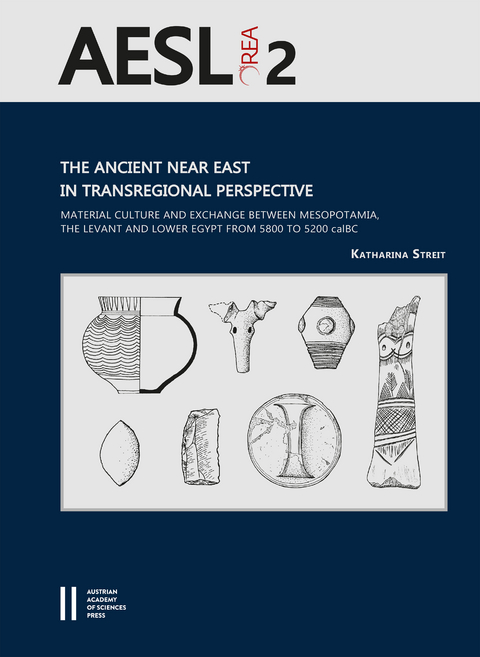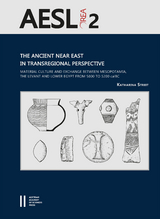The Ancient Near East in Transregional Perspective
Material Culture and Exchange between Mesopotamia, the Levant and Lower Egypt from 5800 to 5200 calBC
Seiten
2020
|
1. Auflage
Verlag der österreichischen Akademie der Wissenschaften
978-3-7001-8396-9 (ISBN)
Verlag der österreichischen Akademie der Wissenschaften
978-3-7001-8396-9 (ISBN)
- Titel nicht im Sortiment
- Artikel merken
This volume examines in detail the distinct cultural entity of the Wadi Rabah culture in the southern Levant and its interconnections and interactions to the cultural entities of northern Levant, northern Mesopotamia and Egypt between ca. 5800 and 5200 cal BC. Previously unnoticed parallels in material culture and cultural practice are analyzed systematically and it is proposed that the center of the transregional cultural entity that influenced the southern Levant lays in the northern Levant and northern Mesopotamia.
In the late 1950s, Jacob Kaplan recognized the Wadi Rabah culture as a distinct cultural entity of the southern Levant, and suggested possible interconnections to the northern Levant, Mesopotamia, and Egypt. This volume examines Kaplan's suggestion in detail and explores the cultural entities of northern Mesopotamia, the Levant and Egypt between ca. 5800 and 5200 cal BC, and the interactions between them. In this process, the 6th millennium BC witnessed a densely woven network of trade and cultural interactions that formed the first known transregional cultural entity. This faded in the following period as its component regions reverted to cultural individuality, and was not seen again in this intensity until the Bronze Age. This examination crosses over modern political boundaries and different academic traditions, research emphases and methodologies. Based on a firm chronological framework, developed for each region based on Bayesian modeling of available radiocarbon dates, the main traits in settlement patterns, material culture, funerary rites, art, and subsistence strategies are outlined in order to analyze previously unnoticed parallels in material culture and cultural practice between the four regions systematically. Evidence of imported raw materials or finished goods is reviewed in detail, all of these collected links and interactions are discussed in a wider geographic context. Mechanisms that could underlie this interactions are examined and possible transregional dynamics are proposed. It is suggested that the center of the culture that influenced the region lays in the northern Levant and northern Mesopotamia.
In the late 1950s, Jacob Kaplan recognized the Wadi Rabah culture as a distinct cultural entity of the southern Levant, and suggested possible interconnections to the northern Levant, Mesopotamia, and Egypt. This volume examines Kaplan's suggestion in detail and explores the cultural entities of northern Mesopotamia, the Levant and Egypt between ca. 5800 and 5200 cal BC, and the interactions between them. In this process, the 6th millennium BC witnessed a densely woven network of trade and cultural interactions that formed the first known transregional cultural entity. This faded in the following period as its component regions reverted to cultural individuality, and was not seen again in this intensity until the Bronze Age. This examination crosses over modern political boundaries and different academic traditions, research emphases and methodologies. Based on a firm chronological framework, developed for each region based on Bayesian modeling of available radiocarbon dates, the main traits in settlement patterns, material culture, funerary rites, art, and subsistence strategies are outlined in order to analyze previously unnoticed parallels in material culture and cultural practice between the four regions systematically. Evidence of imported raw materials or finished goods is reviewed in detail, all of these collected links and interactions are discussed in a wider geographic context. Mechanisms that could underlie this interactions are examined and possible transregional dynamics are proposed. It is suggested that the center of the culture that influenced the region lays in the northern Levant and northern Mesopotamia.
is a researcher at the Institute for Oriental and European Archaeology at the Austrian Academy of Sciences
| Erscheinungsdatum | 13.11.2020 |
|---|---|
| Reihe/Serie | Archaeology of Egypt, Sudan and the Levant (AESL) ; 2 |
| Zusatzinfo | zahlr. s/w-Abb. |
| Verlagsort | Wien |
| Sprache | deutsch |
| Maße | 210 x 297 mm |
| Gewicht | 1267 g |
| Einbandart | gebunden |
| Themenwelt | Geisteswissenschaften ► Archäologie |
| Geschichte ► Allgemeine Geschichte ► Vor- und Frühgeschichte | |
| Schlagworte | chalcolithic • Egypt • Exchange systems • Halaf Culture • Levant • Mesopotamia • Pottery Neolithic • Trade • Transregional Interaction • Wadi Rabah Culture |
| ISBN-10 | 3-7001-8396-8 / 3700183968 |
| ISBN-13 | 978-3-7001-8396-9 / 9783700183969 |
| Zustand | Neuware |
| Informationen gemäß Produktsicherheitsverordnung (GPSR) | |
| Haben Sie eine Frage zum Produkt? |
Mehr entdecken
aus dem Bereich
aus dem Bereich
Was Pompeji über uns erzählt
Buch | Hardcover (2023)
Propyläen (Verlag)
32,00 €
auf den Spuren der frühen Zivilisationen
Buch | Hardcover (2023)
C.H.Beck (Verlag)
20,00 €




